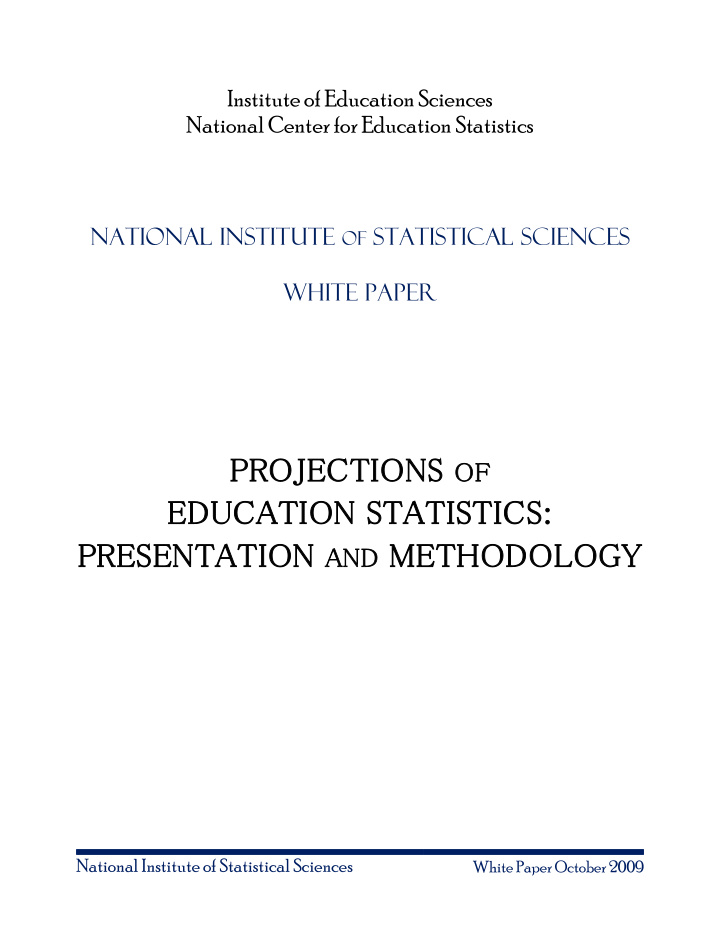



Institute of Education Sciences National Center for Education Statistics National Institute OF Statistical Sciences White Paper PRO PROJEC ECTIO IONS OF ED EDUCATION S STATIS ISTIC ICS: PRESENTA NTATI TION AND AND MET ETHODOLOGY National Institute of Statistical Sciences White Paper October 2009
P ROJECTIONS OF E DUCATION S TATISTICS : P RESENTATION AND M ETHODOLOGY T ABLE O F C ONT NTENTS E OF Executive Summary ............................................................................................................................................ 3 I. Presentation of Projections .................................................................................................................... 4 1.1 Graphics .......................................................................................................................................... 4 1.1.1 Principal Items ............................................................................................................................ 4 1.1.2 Additional Items ......................................................................................................................... 7 1.2 Maps ............................................................................................................................................. 11 1.3 Tables ............................................................................................................................................ 11 1.3.1 Principal Items .......................................................................................................................... 11 1.3.2 Minor Items .............................................................................................................................. 13 1.4 Interactivity ................................................................................................................................... 16 II. Projection Methodology ....................................................................................................................... 19 2.1 Modeling Approach ...................................................................................................................... 19 2.2 Description of the Methodology in Appendix A of Hussar and Bailey (2008) .............................. 22 2.3 Improving the Methodology ........................................................................................................ 24 III. Other Issues .......................................................................................................................................... 25 Appendix A: References ........................................................................................................................... 27 Appendix B: Figures from Hussar and Bailey (2008)................................................................................ 28 Appendix C: Author .................................................................................................................................. 37 2
P ROJECTIONS OF E DUCATION S TATISTICS : P RESENTATION AND M ETHODOLOGY National Institute OF Statistical Sciences white paper PROJECTIONS OF EDUCATI TION STA TATIST STICS: PRESE SENTATION AND ND METHODOLOGY E XECU TIVE S UMMA MMARY CUTI This white paper is an extended review of NCES’ annually issued report containing projections, exemplified by Hussar and Bailey (2008), from methodological (§3) as well as presentation (§2) perspectives. While the paper contains criticisms, they are meant to be constructive, and are in no sense criticisms of the authors. Especially in the discussion of presentation, every criticism is accompanied by at least one suggested alternative. 1 None of these alternatives would be difficult to implement, except to the extent that some of them may conflict with the NCES statistical standards (National Center for Education Statistics, 2004). The discussion of projection methodology, by contrast, is critical without detailed consideration of alternatives. This reflects the magnitude of the effort that would be needed to develop new methodology, which is discussed in §3.3. One very broadly applicable comment is important for both current and future editions. Although Hussar and Bailey (2008) is explicit about omissions, the collective effect of these omissions is large and increasing . Examples noted in Hussar and Bailey (2008) include home schooling (page 1) and high school completers by means other than diplomas granted by school authorities (page 11), postsecondary enrollment in non- degree-granting institutions (implicitly on page 9) and possibly others. Additional examples that may not be addressed include distance learning and US citizens enrolled in institutions outside the US. 2 It would be very valuable to list these omissions in one prominent place. More importantly, in the longer run NCES should devote effort to addressing them, since otherwise the information in successors to Hussar and Bailey (2008) will be increasingly incomplete. 1 For expediency, virtually all of these were produced using some combination of Microsoft Excel, Microsoft Visio and Adobe Photoshop. Versions produced by professional graphics software would be even better. 2 It is not clear, for instance, whether data in Hussar and Bailey (2008) include schools operated by the US Department of Defense. 3
P ROJECTIONS OF E DUCATION S TATISTICS : P RESENTATION AND M ETHODOLOGY National Institute OF Statistical Sciences White Paper P ROJ OF E DUC N S TA STICS : OJECTIONS ONS O UCAT ATION TATI TISTI P RESENT N AND M ETHOD OGY NTATION AND ODOL OLOG I. PRESENTATION OF PROJECTIONS Hussar and Bailey (2008) is very complete, and appears to contain relatively few outright errors. 3 It is not, however, an especially user-friendly document. A relatively small number of changes would increase both the amount of information conveyed to readers and the clarity with which that information is transmitted. We describe these changes, none of which is esoteric, in this section. All of this section other than §2.4 addresses presentation of projections in a printed document. Some opportunities associated with interactive, web-based presentation are discussed in §2.4. 1997). Wilkinson’s Grammar of Graphics (Wilkinson, 2005) does underlie many of the comments. 1.1 Graphics This section is intended to be extremely concrete. Therefore, there are no mentions of the extremely intriguing and important but often somewhat philosophical tenets of Tufte (Tufte, 1983, 1990, 1997). Wilkinson’s Grammar of Graphics (Wilkinson, 2005) does underlie many of the comments. 1.1.1 Principal Items A dramatic improvement to presentation would be to replace vertical bar charts by horizontal bar charts . For concreteness, consider Figure A of Hussar and Bailey (2008), 4 which is inefficient because the width of the bars there is determined by the need to put numbers above them. Consider instead Figure 1, which is a horizontal version; by comparison with Figure A of Hussar and Bailey (2008), 1. The expanded physical scale makes comparisons easier. 2. The horizontal version reveals more about small values. See also discussion of the disparate scales issue below. 3. The horizontal version includes both actual values and percentage changes from one time period to the next. 4. Year labels are explicit. Note that Figure 1 contains low-key vertical lines, beneath all other graphical elements, that carry the numerical scale associated with the x -axis through the entire chart. These are much easier to follow than the tick marks in Figure A of Hussar and Bailey (2008). 3 But, see discussion in §2.3.1. 4 Throughout this section, we illustrate each problem, as well as potential solutions, using only one figure in Hussar and Bailey (2008). It is straightforward to determine which other figures share the same problem and are amenable to the same solutions. 4
Recommend
More recommend